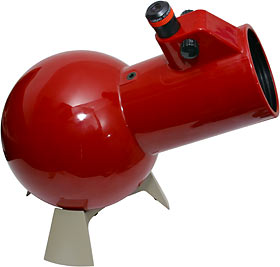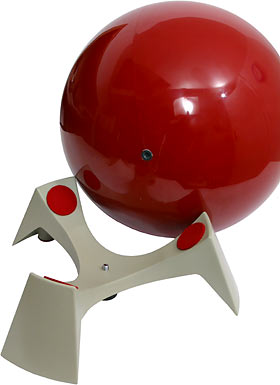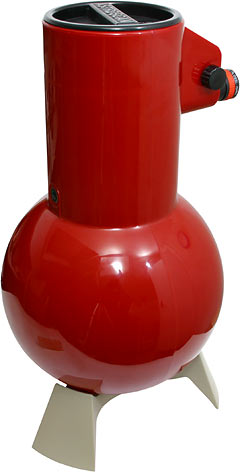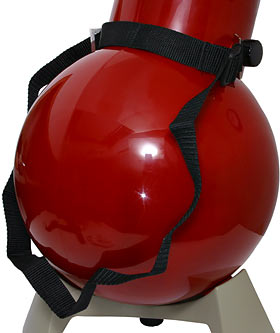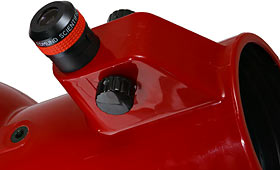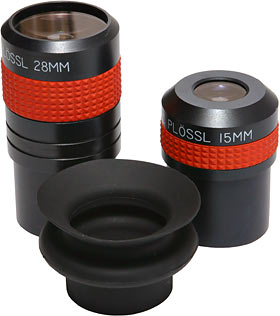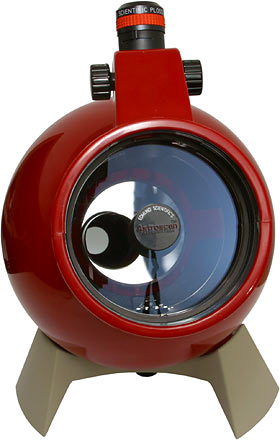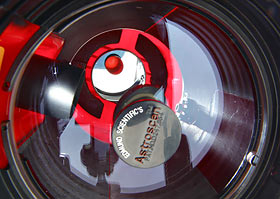
Edmund Scientific Astroscan telescope
Review date: 30 April 2004.Last modified 06-Dec-2007.
When most people think of a telescope, they don't think of something that looks like this.
Show this picture to any astronomy enthusiast, though, and they'll immediately know what it is.
It's not a giant Thermos flask, or some kind of trench mortar, or (as has been noted in literature) a bomb. It's the Edmund Scientific Astroscan, and it's something of a timeless classic of the basic astronomy world. Despite the fact that it's been around for about 28 years (at time of writing), it remains an excellent all-round basic telescope.
Very round, in fact.
The globular base of the Astroscan fits into this simple cast aluminium stand. Three felt pads between plastic and metal let you swivel the 'scope to any angle. You can also leave the base behind and sit the 'scope in your lap, or hang it from a strap (of which more in a moment).
If you like ten-dollar words, you can call this a "ball type cast aluminium altazimuth mount". The important thing about it is the complete freedom of movement it gives - including the freedom to turn the telescope around its long axis, to point the eyepiece in whatever direction suits you while keeping the 'scope's aim the same.
The down side is that very fine control of aiming is pretty much impossible. But you're not meant to be using this telescope at very high magnification, so felt-on-plastic works fine.
The Astroscan's pretty darn portable even with its base. It only weighs about 5.8 kilograms (12.75 pounds) with the base; about 0.9 kilos (two pounds) less without it.
The Astroscan itself is about 43cm long; the bulge at the bottom's 25cm wide (17 inches long, 10 inches wide).
So this is a telescope you can go hiking with. It won't fit in a small backpack, but it's not a big load.
A screw through the middle of the base lets you lock the Astroscan down onto it, like this, for transport or storage. Or for those times when you're quite sure you only want to look straight up.
When you're not using your Astroscan, you plug a big push-in lens cap into the business end, and there's also a plastic cap that replaces the eyepiece - I neglected to put that in place for the above picture.
The thread the Astroscan's base locking screw uses is the same as the one used on ordinary camera tripods, so if you remove the locking screw completely from the base, you can attach the base to any normal tripod. This is handy if there's no table-like object where you want to do your stargazing; if you just sit the Astroscan's base on the ground you'll have to curl up to peer into the eyepiece.
Because of the standard thread, it's possible to attach the Astroscan directly to a tripod head, but its considerable offset weight will be too much for most tripods to hold up at angles far off vertical. Screwing the Astroscan's base onto the tripod and sitting the telescope in it lets the tripod head stay vertical, while you swivel the 'scope in its base as if it were sitting on a table.
The quick-release plate for my Manfrotto tripod didn't fit properly between the legs of the Astroscan base, but that's nothing that a longer screw and a few washers won't solve. You might not be able to get the base onto a really cheap tripods with no detachable mounting plate at all, but tripods that do have a plate (and for which you can buy extra plates, one for everything you want to put on the 'pod) start at quite reasonable prices.
And, of course, Edmund also sell a dedicated Astroscan tripod, along with a bunch of other accessories for the 'scope.
If you want to ditch the base altogether, this strap (which screws into sturdy sockets on either side of the Astroscan's barrel) lets you do it.
The strap is, intentionally, rather short. You can use it to sling the 'scope over your shoulder for carrying, and you can also slip it over your head and hang the 'scope from it, to help you keep the view steady as you cradle the Astroscan in your arms. This way of supporting the Astroscan won't let you use a lot of magnification, but with a wide angle eyepiece it works OK.
Just try not to accidentally head-butt the telescope the first time you squeeze your, apparently, freakishly large head through the strap.
I didn't do that myself, of course. I'm just warning others.
One of the strap screws does double duty; it allows you to affix this basic bent-aluminium peep-sight to the telescope. You don't really need a sight at all if you're using a wide-view eyepiece and have some basic star-spotting skill, but it's handy for higher magnification. If you find yourself using the sight a lot, upgrading to a Rigel Quikfinder or similar more sophisticated no-magnification finder might be a good idea.
The lookin' end.
Like all proper telescopes, the Astroscan can accept a variety of different eyepieces. You slide them into a simple friction-fit tube (of standard 1.25 inch diameter), and the focus mechanism moves the tube in and out. The Astroscan's focuser is not very high-tech; it's just a rubber roller pushing against the eyepiece tube.
The primary difference between eyepieces is their magnification. A telescope's overall magnification is equal to its objective (lens or mirror) focal length divided by the focal length of the eyepiece; the shorter the eyepiece focal length, the more magnification you get.
This basic Astroscan package comes with two Plossl eyepieces (or Plössl eyepieces, if you want to be all umlauty and correctly reflect the name of the Viennese inventor of the things, back in 1860); a 28mm wide angle, and a 15mm for getting closer. The Astroscan's objective focal length is 445mm, so the 28mm objective gives about 16X magnification, and the 15mm gives about 30X.
Plossls are a good eyepiece price/performance compromise; they give a decent apparent field of view (how big the image appears to be when you look into the eyepiece), but don't add terrifying amounts to the cost of your 'scope package. It's quite easy to spend much more on one fancy ultra-wide eyepiece than the whole Astroscan package costs.
There's also a rubber eyecup that you can wrestle onto an eyepiece if you like, but it's optional, and not very useful at all for ordinary night-time viewing.
The rubber eyecup, by the way, came in a little bag stapled to this warning card. This side of the card makes clear that when the piece of rubber kills you, it's not Edmund's fault.
The other side of the card tells you about latex allergies, which is presumably how the eyecup is going to kill you.
30X magnification doesn't sound like much by the standards of the average discount-store telescope (of which more in a moment...), but it's actually quite adequate for a lot of stargazing. A lot of things in the sky are surprisingly big - they're just rather dim. You need light-gathering ability (and a dark, non-light-polluted sky) to see them, not zillion-times magnification.
The angular size of the moon, for instance, is about half a degree (30 arc minutes). It may look big, especially when it's close to the horizon, but the tip of your little finger at arm's length should cover it with plenty of room to spare.
The M42 nebula, in contrast, is some 66 by 60 arc minutes - it'd take a two-by-two block of moons to cover it. But it's not very visible to the naked eye, because it's not very bright.
A good telescope brightens up nebulae and galaxies and comets so that you can see them, without necessarily needing to make them a whole lot bigger.
In theory, the Astroscan's good for about 200X magnification for night-time use, though its simple aiming mechanism and less-than-totally-perfect main mirror mean you really ought to consider a more expensive 'scope if you intend to go much above 100X. Edmund recommend you not try higher than 35X, simply because of the aiming problem.
In the light of day, you can get much higher magnification out of all kinds of telescopes, including the Astroscan, but the aiming problem remains, and high magnification is often surprisingly pointless if you're looking a reasonable distance. Disturbances in the air (it doesn't need to be very hot for heat haze to appear over a few kilometres...) impose a limit on the resolution you can achieve in the daytime, unless you're looking up at the sky - where there's not a whole lot to see in the daytime.
(There is, of course, the sun. You can view the sun with an Astroscan, if you buy or rig a viewing screen. Peering through the eyepiece at the sun is an express ticket to monocular vision.)
Other bundle-stuff
Edmund sent me the basic Astroscan package, which they sell for $US199. There are plenty of Astroscan-compatible accessories available from Edmund and others, but there's nothing vital left out of the basic package.
Apart from the above-displayed hardware, you get an excellent Using Your Astroscan guide, which suffers not at all for not having been revised since 1979. Today's telescopes don't usually have a bikini girl magnification example on page 12 of the manual, but I ain't complainin'.
You also get one of Edmund's standard books, "The Edmund Sky Guide", co-authored by Terence Dickinson.
Unfortunately for me, this is one of those northern hemisphere astronomy books that's of limited utility to someone who lives in Australia. For the same reason, the nifty rotating Star And Planet Locator that also comes with the Astroscan isn't any good to me.
There's still value to the material in the Sky Guide about how stars appear to move, how to find them, and the behaviour of telescopes, though.
Beyond eyepieces
You can attach cameras to all proper telescopes, and the Astroscan's no exception. Edmund sell an "eyepiece projection" camera adapter for it; eyepiece projection points a camera at a telescope eyepiece, and lets you strap on regular point-and-shoot digicams, as well as SLRs.
You can also use a simple empty-tube "prime focus" adapter with the Astroscan, but that won't give you as much magnification, and with many cameras will restrict the image to a small circle in the middle of the film (or digital sensor). You can use a "Barlow lens" between 'scope and camera to enlarge the image, but eyepiece projection is still likely to work better.
There's something to be said for good old SLR film cameras when doing astrophotography, mainly because they allow very long exposure times with no noise problems. A few digital cameras these days - including my Canon EOS-D60 - are capable of exposures of many minutes without delivering noise-storm results, but film can be exposed all night with no problem.
This is irrelevant for Astroscan users, though, because there's no motor-drive option for the Astroscan; you need a motor drive that synchronises the telescope movement to the rotation of the earth if you want to do long exposure astrophotography without creating an artistic but uninformative image in which the stars turn into lots of concentric circles.
You can still pull a lot more detail out of the sky with a camera than you can with your naked eye, though, even if the lack of a motor drive restricts you to relatively short exposures. The earth rotates 15 degrees per hour, which makes stars fairly zip across a magnified field of view, when you're looking at stuff close to the celestial equator. The Astroscan's widest field of view is about three degrees - this makes it a "wide field" telescope, between the usual field of view of telescopes and binoculars. An equatorial star will cross three degrees in 12 minutes; the more magnification you use, the faster things will seem to move.
Even if your exposure is only a few seconds, though (figuring out exactly how much you can get away with can be a little complex), it'll still pull more light and colour out of the scene than your miserable eyes can manage. With the naked eye, nothing viewed through any amateur telescope will show any colour to speak of; with a camera, you can bring it out.
The other reason why a film camera might be a better choice, apart from the fact that it doesn't cost much to buy the sort of old all-manual cable-release film SLR that's all you need for astrophotography, is that film cameras generally weigh less than long-exposure-capable digital SLRs.
Camera adapters are a considerable load even for small telescopes rather fancier than the Astroscan. On an Astroscan, the weight of a camera will definitely give the rubber roller focus mechanism something to think about, not to mention make the ball aiming system exceedingly cumbersome.
Still and all, though - you can do it. And you can use the Astroscan as a daytime telephoto lens, too; elegant it ain't, but something in the order of 2000mm of 35mm-equivalent telephoto power is nothing to sneeze at.
How it works
When not starring in large books or devising laws of motion, Isaac Newton spent a couple of lazy afternoons devising a new kind of telescope - the reflector. The basic kind of reflector telescope is still called a Newtonian, and that's what the Astroscan is.
A Newtonian reflector telescope is a tube with two mirrors in it. The main, curved mirror is at the bottom of the tube; light comes down the tube, hits that mirror and is reflected back up the tube, towards the second mirror. That one's smaller, flat, and angled at 45 degrees; it reflects the light out at right angles into an eyepiece connected to the side of the telescope.
Peering down the barrel of the Astroscan lets you see both of these mirrors. Once you get past its bubble-bottomed casing, the Astroscan's a classic Newtonian.
The eyepiece tube's protruding into the barrel at the top left in this picture; the back of the angled mirror's visible in the middle.
The wide-angle lens I'm using for this shot makes the main mirror look further away than it really is. In the main mirror, you can see the reflection of the angled mirror, which in turn is reflecting a view of the red plastic cap that's plugged into the eyepiece tube.
The Astroscan's main mirror has a diameter of 4.25 inches, but when you take into account the light loss from the angle-mirror obstruction, its effective diameter is 4 and an eighth inches - 105mm. This is a pretty big aperture for a 'scope a kid can carry.
Newtonian reflectors can have a lot more aperture (and thus light-gathering ability) than refracting telescopes of similar length, and they're inherently "apochromatic" - they have no chromatic aberration, in which different colours in the image are focussed in different places. There may be a little chromatic aberration from the eyepiece lenses, but that's it.
On the down side, Newtonians tend to suffer from "coma", where things that aren't in the middle of the field of view are fuzzy. The Astroscan has a mild dose of this problem, but it's quite acceptable at this price point.
Why I like it
There are five qualities a basic telescope should have. The Astroscan has all of them.
The first thing a basic telescope should do is, you know, work. It should let you look at stuff.
That $US50 "Professional Telescope" you see on sale on eBay (or at a department store for $US75 or more) will not pass this first test. Actually, you can spend a fair bit more than this and still end up with a really awful telescope.
Read basic telescope guides and, frequently, the first thing mentioned will be that if it's in a department store, it's rubbish. Nowhere that sells socks also sells good telescopes.
Even a crummy telescope may be acceptable if all you want is to invade the privacy of the people in the apartment building across the street, but even that may be beyond the capabilities of a department store 'scope.
Lousy 'scopes with light leaks and poorly aligned, poorly coated glass may have a great big magnification figure on the side of the box, but will give you a fuzzy, washed-out view considerably inferior to that from a much lower magnification pair of binoculars costing the same amount of money.
On the plus side, a cheapo telescope is virtually certain to be a "terrestrial" type, which'll show you things the right way up. "Astronomical" telescopes (including the Astroscan) normally show things upside down, because that's the simplest way to build the optics; it minimises loss of light and image quality. You have to add an "erector" to the eyepiece to flip the image. Naturally, Edmund stock an erector for the Astroscan, though the telescope's standard eyepiece mount will accept various others.
A basic telescope should also be easy to set up. Point and shoot, not unpack and assemble and level and calibrate and wind and fiddle and point and repoint and tweak and curse. Another win for the Astroscan. Newtonian 'scopes are usually fussy beasts, requiring frequent re-alignment of the mirrors and very careful handling. The Astroscan Contains No User-Serviceable Parts, and Just Works.
And a basic telescope should be portable. If you live in a big city, light pollution will make a lot of astronometric exertions futile. But if your telescope fits in a backpack, you can take it any darn place.
In a lot of parts of the world, definitely including Australia where I live, a drive of an hour or two will get you far enough away from badly designed streetlights (like those "orb" lights that fling photons everywhere except down around the light itself...), giant searchlight-tipped casinos and idiotic upward-facing decorative pavement lights that you'll be able to see cool stuff, even through a cheap-ish telescope that a kid can carry.
You can, of course, view the moon even if you live in Las Vegas; the moon's lit by direct sunlight, so it can drown out any amount of light pollution. 30X magnification is quite enough to make the moon look big - getting on for the size of a basketball held at arm's length. The Astroscan with its stock eyepieces is a great moon-viewing telescope.
The planets are easy to view in light-polluted skies, too, though an Astroscan has a hard time resolving them as more than featureless circles if you don't get an eyepiece that pushes its magnification hard.
As for everything else, though... well, you'll be able to see a tantalising graininess when you look at the light-polluted sky, showing you how many stars and other interesting things are trying to make themselves known to you, but you're going to have to get the hell out of Dodge if you want to see what they actually are.
Along with portability comes toughness. No telescope can be used to hammer in tent pegs (well, actually, many astronomers would opine that recent Tascos should be), but if you bump the thing on the door frame on the way out you shouldn't then have to spend an hour recalibrating it. The Astroscan passes this test; its glue-mounted mirrors are there to stay, unless you're extremely impolite to it.
A basic telescope should also not cost a fortune. You've got to accept that you're not going to get anything decent for fifty bucks, but if your telescope could cost, say, a fifth as much as a basic PC, that'd be good.
The basic Astroscan package costs $US199 today, which is rather less than it used to cost. Back in 1979 (when it was still called the "Astroscan 2001"; the then-futuristic number on the end of its name was quietly deleted a while ago), it retailed for $US169.95. That's an easy $US450 in 2004 dollars.
Compare and contrast
The Astroscan's, ah, ball type altazimuth mount, has been used by a few other telescopes.
For instance, there's the much younger, and somewhat cheaper, Bushnell Voyager model 78-2010. Check it out.
Noooo, it's not an Astroscan clone! It's not red!
The Bushnell Astroscan-alike doesn't stink, but it's got a spherical main mirror rather than the Astroscan's parabolic mirror. Spherical mirrors aren't as good; they have aberration problems, so the Bushnell will never focus quite as well as the Astroscan.
It's generally agreed that the Astroscan, despite its age, is a better piece of gear than the black Bushnell.
Even further down the cost ladder, there's the very cheap Orion FunScope.
(And you thought the Astroscan looked a bit wussy.)
The FunScope makes the Astroscan look big, and might be a good option if you're buying for a kid, but Orion's more expensive and less cute StarBlast seems to be more highly recommended.
The Astroscan ball-mount idea isn't exclusive to cheap 'scopes, by the way. Portaballs use it, and their prices start from $US2400.
Obviously, though, even the smallest Portaballs aren't competing with little 'scopes like the Astroscan.
(If you're some kind of hulk, I guess you could tote a Portaball in a backpack.)
Overall
Look at the 28-year-old Astroscan today, and it really doesn't look antiquated at all. It looks as weird as it did on the day it was born, it works just as well, it costs less, and the total number of telescopes in its market niche is now... two.
If you've toyed with the idea of buying a telescope, and want to get something decent, but don't want to drop big dollars on a computerised hyper-scope or dedicate a large chunk of your life to the obscure rituals of the from-scratch telescope builder, an Astroscan remains a pretty darn brilliant introduction to the hobby.
Maybe it'll lead to something more, maybe it won't, but you really won't find a better introduction to the hobby anywhere, and even if you move on to a severe case of astrophilia, your Astroscan will probably still get used.
I like this funny little thing a lot. Highly recommended.
Review Astroscan kindly provided by Edmund Scientific.
If you live in the USA, you can buy an Astroscan from Edmund directly. It'll cost you $US199 plus delivery for the basic package.
[UPDATE: This review is several years old now; I think most Astroscan packages are now a little more expensive.]
You can also find Astroscans on Amazon.
If you don't live in the USA, things are a bit more complex. Edmund don't currently ship outside the USA, but their sibling site Ward's Natural Science does, and will even do so for a tolerable price after a certain amount of back-and-forth, according to one of my readers.
Don't expect to be able to find an Astroscan in your local telescope shop if you're not in the States; Edmund apparently don't currently distribute their products to other resellers. You may well be able to find something like the abovementioned Bushnell clone or Orion StarBlast, though.
There are also onshipping services that send packages from US dealers to various other countries, including Australia - see MyUS and HopShopGo, for instance (this is not a recommendation of these particular onshippers - they're just the first that came up in a search).
Astroscans and accessories for them also turn up on eBay from time to time.
(If you're in Australia, try this search for eBay Astroscans. If you're in the UK, try this one.)
